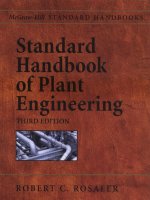Handbook of plant based biofuels - Chapter 3 ppt
Bạn đang xem bản rút gọn của tài liệu. Xem và tải ngay bản đầy đủ của tài liệu tại đây (295.61 KB, 16 trang )
29
3
Thermochemical
Conversion of
Biomass to Liquids
and Gaseous Fuels
Hari Bhagwan Goyal, Rakesh Chandra Saxena,
and Diptendu Seal
CONTENTS
Abstract 30
3.1 Introduction 30
3.2 Biomass Conversion Processes 32
3.2.1 Thermochemical Conversion Processes 32
3.2.1.1 Combustion 32
3.2.1.2 Gasication 33
3.2.1.3 Pyrolysis 33
3.2.1.4 Liquefaction 34
3.2.1.5 Hydrogenation 34
3.3 Pyrolysis of Biomass to Liquid Fuels 34
3.3.1 Slow Pyrolysis 35
3.3.2 Fast Pyrolysis 35
3.3.3 Flash Pyrolysis 35
3.3.4 Mechanism of Pyrolysis of Biomass 36
3.3.4.1 Pyrolysis of the Cellulose 37
3.3.4.2 Pyrolysis of the Hemicellulose 37
3.3.4.3 Pyrolysis of Lignin 37
3.3.5 Pyrolysis Reactors 38
3.3.6 Properties of Bio-Oils 38
3.3.7 Composition of Bio-Oil 39
3.3.8 Composition of Pyrolysis Gas and Char 40
3.3.9 Uses of Bio-Oil and Char 40
3.4 Hydrogen from Biomass 41
3.4.1 Pyrolysis 41
3.4.2 Supercritical Water Extraction 41
3.4.3 Gasication 42
3.5 Conclusion 42
Acknowledgments 43
References 43
© 2009 by Taylor & Francis Group, LLC
30 Handbook of Plant-Based Biofuels
ABSTRACT
Energy management will be difcult for the coming generations due to increasing
demand for energy caused by rapid industrialization and social growth. The emerg-
ing alternative and renewable energy resources are expected to play an important
role in energy consumption scenarios of the future, particularly to handle environ-
mental concerns. Biomass is renewable, clean, and abundantly available and its
thermochemical conversion to liquid and gaseous fuels is one of the prospective
approaches. Various thermochemical conversion processes, namely, combustion,
gasication, liquefaction, hydrogenation, and pyrolysis have been considered for
converting biomass into liquid and gaseous fuels. The pyrolysis process has received
considerable attention as it converts biomass directly into solid, liquid, and gaseous
products by thermal decomposition of biomass in the absence of oxygen.
This chapter focuses on pyrolysis; other conventional thermochemical processes
are discussed briey. Various types of pyrolysis processes, namely, slow, fast, ash,
and catalytic processes are discussed in detail to provide better insight into these
thermochemical processes. Besides properties of biomass, the composition and use
of pyrolysis products are also discussed in detail. In addition, various thermochemi-
cal processes, such as pyrolysis and supercritical water extraction gasication for
hydrogen-rich gas production are also highlighted.
3.1 INTRODUCTION
The demand for energy is growing faster due to rapid industrialization and social
growth. Conventional energy sources, such as coal, oil, and natural gas, have limited
reserves that are expected not to last for an extended period. Consequently, energy
management will be difcult for the coming generations (Adhikari et al. 2006). In
addition, environment-related problems associated with conventional energy sources
are continuously increasing. Over the last half century, a trend toward continuous
increases in the average atmospheric temperature has been observed, totalling a half
degree centigrade (Goyal et al. 2005) This trend may lead to natural calamities such
as excessive rainfall and consequent oods, droughts, and local imbalances. With
increasing energy demand, the emerging alternative and renewable energy resources
are expected to play an increasing role in future energy consumption, at least in order
to reduce the environmental concerns.
In contrast to conventional energy sources, nonconventional energy sources such
as wind, sunlight, water, and biomass have been used since ancient times. Biomass
is now being considered as an important energy resource all over the world and
is being used to meet a variety of energy needs, including generating electricity,
fueling vehicles, and providing process heat for industrial facilities. Among all the
renewable sources of energy, biomass is unique as it effectively stores solar energy.
It is the only renewable source of carbon that can be converted into convenient solid,
liquid, and gaseous fuels. Biomass is the fourth largest source of energy in the world,
accounting for about 15% of the world’s primary energy consumption and about 38%
of the primary energy consumption in developing countries (Chen, Andries, and
Spliethoff 2003).
© 2009 by Taylor & Francis Group, LLC
Thermochemical Conversion of Biomass to Liquids and Gaseous Fuels 31
The term biomass generally refers to any living matter available on the earth.
However, in the present context, only plant materials would be considered as bio-
mass. Plants produce carbohydrates through the process of photosynthesis using
CO
2
, water, minerals, sunlight, and chlorophyll. Carbohydrates, which make up the
bulk of tissues, trap the solar energy in their chemical bonds. It is these energy-rich
bonds, when broken via different processes, that produce energy (Goyal et al. 2006).
There is a need for an environmentally benign, cheap, and efcient process that can
extract stored solar energy from waste biomass.
Biomass resources that can be used for energy production cover a wide range of
materials, which include wood and wood wastes, agricultural crops and their waste
by-products, waste from food processing, municipal solid waste, aquatic plants and
algae, etc. Plant-based biomass can be divided into three major categories, residues
from agriculture production, forest products, and energy crops. Energy crops include
short rotation woody crops, herbaceous woody crops, grasses, starch crops, sugar
crops, oilseed crops, etc. The choice of biomass for the production of energy and the
type of process to be used for its conversion depends on the chemical and physical
properties of the large molecules from which it is made. The major components pres-
ent in any biomass are:
1. Cellulose: Cellulose is a linear chain polymer of (1, 4)--glucopyranose
units. The units are linked 1-4 in the β-conguration. It has an average
molecular weight of around 100,000 Da and general formula of C
6
H
10
O
5
.
2. Hemicellulose: These are the complex polysaccharides that exist in associa-
tion with the cellulose in the cell wall and consist of branched structures,
which vary considerably with different biomass. It is a mixture of monosac-
charides such as glucose, mannose, xylose, and arabinose, as well as meth-
lyglucoronic and galaturonic acids, having an average molecular weight of
<30,000 Da.
3. Lignin: Lignins are highly branched, substituted, mononuclear aromatic
polymers in the cell walls of certain biomass, especially woody species,
and are often adjacent to cellulose bers to form a lignocellulose complex.
Lignin is regarded as a group of amorphous, high-molecular-weight, chemi-
cally related compounds.
In most kinds of biomass, cellulose is generally the largest fraction, about 40 to
50% by weight, followed by hemicellulose about 20 to 40%. Besides these, biomass
also has other components (Bridgwater, 1999). Table 3.1 highlights different types of
biomass with their compositions.
Due to its renewable and environmentally friendly nature, the use of biomass
for production of energy would result in a net reduction in greenhouse gas emission.
Furthermore, biomass-derived fuels have negligible sulfur content and, therefore, do
not contribute to the emission of sulfur dioxide, which causes acid rain. The combus-
tion of biomass produces less ash than coal combustion. Moreover, the ash produced
can be used as soil additive on farms.
© 2009 by Taylor & Francis Group, LLC
32 Handbook of Plant-Based Biofuels
3.2 BIOMASS CONVERSION PROCESSES
Biomass can be converted into useful forms of energy using various processes. The
choice of conversion process depends on the type and quantity of the biomass feed-
stock, the desired form of the energy, that is, end use requirements, environmen-
tal standards, economic conditions, and specic factors for the project (Manuel,
Abdelkader, and Roy 2002).
The two main processes for the conversion of biomass are thermochemical pro-
cesses and biochemical/biological processes (Saxena, Adhikari, and Goyal 2007).
3.2.1 tH e r m o c H e m i c a l co n v e r S i o n Pr o c e S S e S
The thermochemical conversion processes involve heating of biomass at high tem-
peratures. There are two basic approaches. The rst is gasication of biomass and its
conversion to hydrocarbons. The second approach is to liquefy biomass directly by
high-temperature pyrolysis, high-pressure liquefaction, ultra-pyrolysis, or supercriti-
cal extraction. Various thermochemical conversion processes are described below.
3.2.1.1
Combustion
Combustion is the burning of biomass in air. It converts the chemical energy stored
in the biomass into heat, mechanical power, or electricity using different process
equipment, for example, stoves, furnaces, boilers, steam turbines, turbo generators,
etc. Combustion produces hot gases at temperatures around 800 to 1000°C. This is
an older method of utilizing biomass for obtaining energy. Combustion has been
used on a small scale for domestic purposes and on a large scale for industries. On a
small scale, it can be used to provide energy for cooking, space heating, etc. Large-
scale uses include combustion in boilers or furnaces to get heat, generation of steam
for turbines, etc. Co-combustion of biomass with coal is a good option for use in the
production of power on a larger scale. Complete combustion is actually a chemical
reaction of the biomass and oxygen, giving CO
2
, water, and heat. Combustion equip-
ment is available with various designs of the combustion chambers, operating tem-
peratures, etc. Examples are refractory lined furnaces, water wall incinerators, etc.
TABLE 3.1
Biomass Components
Percent, weight
Biomass Cellulose Hemicellulose Lignin
Sugarcane bagasse 38 27 20
Sugarcane leaves 36 21 16
Napier grass 32 20 09
Sweet sorghum 36 16 10
Eucalyptus saligna 45 12 25
Municipal solid waste 33 09 17
Newspaper 62 16 21
© 2009 by Taylor & Francis Group, LLC
Thermochemical Conversion of Biomass to Liquids and Gaseous Fuels 33
The choice of the specic reactor depends on the type of biomass, quantity, and the
required form of nal energy.
The process of combustion has many drawbacks. The biomass rarely exists natu-
rally in an acceptable form for burning. Straw, wood, and some other types of bio-
mass require primary treatment such as compressing, chopping, and grinding for
better combustion, which can be expensive (McKendry 2002). Small-scale applica-
tions, such as domestic cooking and space heating can be very inefcient, with heat
transfer loss of 30 to 90%. Large biomass power generation systems involve higher
cost due to the presence of moisture in the biomass.
3.2.1.2
Gasification
Gasication is the conversion of the biomass into a combustible gas mixture by the
partial oxidation of the biomass at high temperature, in the range of 800 to 900°C.
The following reaction takes place in the reactor during the gasication reaction.
C + O
2
→ CO
2
C + ½ O
2
→ CO
CO + ½ O
2
→ CO
2
CO
2
+ C ↔ 2 CO
Methane and hydrogen formed simultaneously by the thermal splitting of the
organic material may also be combusted and carbon may also be reduced by the
hydrogen present in the gaseous mixture:
CO
2
+ 4 H
2
→ CH
4
+ 2 H
2
O
The resulting gas, known as producer gas, is a mixture of carbon monoxide,
hydrogen, and methane along with carbon dioxide and nitrogen. Various gasiers
are known to run on different types of biomass, such as rice husk, coconut shells,
charcoal, wood, etc. The low caloric value gas produced (about 4–6 MJ/Nm
3
) can
be burnt directly, or can be used as fuel for gas engines and gas turbines. The produc-
tion of synthesis gas from biomass allows the production of methanol and hydrogen,
each of which may have a future as fuels for transportation (Asadullah et al. 2002;
Demirbas 2004).
3.2.1.3
Pyrolysis
Pyrolysis is the heating of biomass in an inert atmosphere. Pyrolysis generally starts
at 300
°
C and continues up to 600–700°C. The biomass is converted into useful liq-
uid, gaseous, and solid products. Details of the pyrolysis process are covered in Sec-
tion 3.3.
© 2009 by Taylor & Francis Group, LLC
34 Handbook of Plant-Based Biofuels
3.2.1.4 Liquefaction
Liquefaction is a low-temperature, high-pressure, thermochemical process using a
catalyst with the addition of hydrogen and producing a marketable liquid product.
High pressure is employed to assure good heat transfer, or to maintain a liquid-phase
system at high temperatures. Interest in liquefaction is low because the reactors and
fuel feeding systems are more complex and more expensive than for the pyrolysis and
gasication processes (Demirbas 2001). The heavy oil obtained from the liquefac-
tion process is a viscous tarry lump, which sometimes causes trouble in handling.
3.2.1.5
Hydrogenation
Hydrogenation is mainly employed for the production of methane by hydro-gasi-
cation. In one of the routes, synthesis gas is produced in the rst step, followed by
reaction with hydrogen to yield methane. In the other route, the feed reacts directly
with the hydrogen; the shredded biomass is converted with the hydrogen-containing
gas to a gas containing relatively high methane concentrations in the rst-stage reac-
tor. The product char from the rst stage is used in a second-stage reactor to generate
the hydrogen-rich synthesis gas. Presently, more attention is focused on two kinds
of processes, pyrolysis to produce liquid fuel, and gasication to produce hydrogen,
as these are environmentally benign and produce a better quality product. These
processes are discussed here in detail.
3.3 PYROLYSIS OF BIOMASS TO LIQUID FUELS
Pyrolysis is the thermal decomposition of an organic material in the absence of oxy-
gen, leading to the formation of liquid, gases, and a highly reactive carbonaceous
char. The quantity and quality of the products depend on various parameters, such
as reaction temperature, pressure, heating rate, reaction time, etc. Chars, organic
liquids, gases, and water are formed in varying amounts, depending particularly on
the biomass composition, heating rate, pyrolysis temperature, and residence time in
the pyrolysis reactor. Lower process temperature and longer vapor residence times
favor the production of charcoal, whereas high temperature and long vapor residence
time increase the gas yields. Moderate temperature and short vapor residence time
are optimum for higher liquid yields (Bridgwater 1994).
The basic phenomena that take place during pyrolysis are as follows:
1. Heat transfer from a heat source, leading to an increase in the temperature
inside the fuel.
2. Initiation of the pyrolysis reactions due to increased temperature, leading to
release of the volatiles and the formation of char.
3. Outow of the volatiles, resulting in heat transfer between the hot volatiles
and cooler unpyrolysed fuel.
4. Condensation of some of the volatiles in the cooler parts of the fuel to pro-
duce tar.
5. Autocatalytic secondary pyrolysis reactions.
© 2009 by Taylor & Francis Group, LLC
Thermochemical Conversion of Biomass to Liquids and Gaseous Fuels 35
The pyrolysis process may be endothermic, or exothermic, depending on the tem-
perature of the reacting system. The process steps include drying the feed, grinding the
feed to sufciently small particles for rapid reaction, pyrolysis reaction, and the separa-
tion of the products (bio-oil). The pyrolysis processes are of the following types.
3.3.1 Sl o w Py r o l y S i S
This is a conventional process whereby the heating rate is kept slow (approximately
5–7°C/min) (Ozbay et al. 2001). This slow heating rate leads to higher char yields
than the liquid and gaseous products. Different kinds of biomass, such as wood sam-
ples, safower seeds, sugarcane bagasse, sunower seeds, municipal wastes, etc., are
generally subjected to slow pyrolysis.
3.3.2 fa S t Py r o l y S i S
Fast pyrolysis is considered a better process than conventional, slow pyrolysis. In
this, the heating rates are kept high, about 300 to 500°C/min and the liquid product
yield is higher. Fluidized-bed reactors are best suited for this process as they offer
high heating rates, rapid devolatilization and also are easy to operate. Reactors such
as entrained ow reactors, circulating uidized-bed reactors, rotating reactors, etc.
are used for this purpose (Table 3.2).
3.3.3 fl a S H Py r o l y S i S
This is an improved version of fast pyrolysis, whereby high reaction temperature is
obtained within a few seconds. The heating rates are very high, about 1000°C/min
with reaction times of few to several seconds. This is carried out at atmospheric pres-
sure. Entrained ow and uidized-bed reactors are the best reactors for this purpose.
Because there is rapid heating of the biomass, for better yields this process requires
smaller particle size (-60+140 mesh) compared to other processes. Flash pyrolysis
can be categorized as:
1. Flash hydro-pyrolysis: The pyrolysis is carried out in the presence of hydro-
gen. It involves a pressure of 20 MPa.
2. Solar ash pyrolysis: Solar energy is used for the pyrolysis process. It is
stored in conventional devices and is used to increase the temperature of the
reaction system.
3. Rapid thermal process: The rapid thermal process involves very short resi-
dence time of 30 ms to 1.5 s and is carried out at temperatures between 900
and 950°C. Rapid heating eliminates the side reactions in the system, with
high yields of the desired product.
4. Vacuum ash pyrolysis: Vacuum pyrolysis incorporates a vacuum in the
pyrolysis system. This stops the secondary decomposition reactions, giving
higher liquid yields, and reduces gas production. The vacuum facilitates
quick removal of the liquid from the system.
5. Catalytic biomass pyrolysis: Catalytic pyrolysis is done to improve the
quality of the oil (the oil from pyrolysis processes is generally unsuitable
© 2009 by Taylor & Francis Group, LLC
36 Handbook of Plant-Based Biofuels
for use in transportation). Catalysts such as zeolites and basic materials
are used for carrying out these reactions (Williams and Nugranad 2000).
The product from catalytic pyrolysis does not require costly techniques to
upgrade the quality of the product.
3.3.4 me c H a n i S m o f Py r o l y S i S o f Bi o m a S S
The mechanism of pyrolysis consists indirectly of the mechanisms of pyrolysis of its
components, that is, cellulose, hemicellulose, and lignin.
TABLE 3.2
Pyrolysis Reactors and Processes
Biomass Type Reactor Type Process Type
Safower seed Fixed bed Slow
Rapeseed Heinz retort Slow
Rapeseed Fixed bed Fast
Rapeseed Tubular transport reactor Flash
Sugarcane bagasse Cylindrical SS reactor Vacuum
Sugarcane bagasse Pilot plant Vacuum
Sugarcane bagasse Wire mesh reactor Flash
Euphorbia rigida Fixed bed Hydropyrolysis
Sunower bagasse Fixed bed –
Hazelnut shells Tubular reactor, xed bed Slow
Wood Fixed bed Slow
Wood Electric screen heater reactor Fast
Wood Fluid bed Fast
Rice husks Fluidized bed Catalytic
Rice husks Fluidized bed Slow
Cotton seed Tubular reactor, Heinz retort –
Cotton seed cake Fixed bed, tubular reactor Slow
Cotton cocoon Tubular reactor Fast, ash
Pinewood Static batch reactor Slow
Softwood Vacuum pyrolysis reactor Vacuum
Hardwood Electric screen heater reactor Fast
Softwood and hardwood Fluidized bed Fast
Lignocell HBS Circulating uid bed reactor Flash, catalytic
Sewage sludge Fluidized bed Slow
Coconut shell Packed bed Slow
Wheat straw Packed bed Slow
Groundnut shell Packed bed Slow
Pine wood Static batch reactor Slow
Forest and agricultural residue Fixed bed reactor Slow, steam
Eucalyptus and pine bark
— Slow and ash
Canadian oil shales Cylindrical SS retort reactor Vacuum
© 2009 by Taylor & Francis Group, LLC
Thermochemical Conversion of Biomass to Liquids and Gaseous Fuels 37
3.3.4.1 Pyrolysis of the Cellulose
Cellulose degradation starts at temperatures lower than 325 K and is characterized
by decreasing degrees of polymerization. The two basic reactions take place in the
thermal degradation of the cellulose: (a) degradation, decomposition, and charring
on heating at lower temperature; and (b) a rapid volatilization accompanied by the
formation of levoglucosan on pyrolysis at higher temperatures.
The glucose chains in the cellulose are rst cleaved to glucose, followed by the
splitting of one molecule of water to give glucosan (C
6
H
10
O
5
). The initial degradation
reactions include depolymerization, hydrolysis, oxidation, dehydration, and decar-
boxylation. The mechanism of the pyrolysis of the cellulose is as follows:
535 K
(C
6
H
10
O
5
)
x
↔ x C
6
H
10
O
5
Cellulose Levoglucosan
C
6
H
10
O
5
↔ H
2
O + 2 CH
3
– CO – CHO
Levoglucosan (Methyl glyoxal)
2 CH
3
-CO-CHO + 2 H
2
↔ 2 CH
3
-CO-CH
2
OH
(Acetal)
2 CH
3
-CO-CH
2
OH + 2 H
2
↔ 2 CH
3
-CHOH-CH
2
OH
(Propylene glycol)
CH
3
-CHOH-CH
2
OH + H
2
↔ CH
3
-CHOH – CH
3
+H
2
O
(Isopropyl alcohol)
3.3.4.2
Pyrolysis of the Hemicellulose
The hemicelluloses, which are present in deciduous woods chiey as pentosans and
in coniferous woods almost entirely as hexosans, undergo thermal decomposition
very readily. Hemicellulose reacts more readily than cellulose during heating. The
thermal degradation of hemicelluloses begins above 373 K.
3.3.4.3
Pyrolysis of Lignin
Lignin is a complex, naturally occurring polymer characterized by the general empir-
ical formula: C
9
H
8-x
O
2
[H
2
] [< 1.0 [OCH
3
]
x
]. It is susceptible to high-yield depo-
lymerization/upgrading, leading to reformulated gasoline compositions as the nal
products. Two different processes have been developed for the degradation of lignin.
The rst is a two-stage process comprised of base catalyzed depolymerization
(BCD) and deoxygenative hydroprocessing (DHP). BCD is carried out in supercriti-
cal methanol reaction medium. This is followed by DHP, resulting in the reformu-
lated hydrocarbons, gasoline, multibranched parafns, C
6
-C
11
mono-, di-, tri-, and
polyalkylated naphthenes, and C
7
–C
11
alkyl benzenes.
© 2009 by Taylor & Francis Group, LLC
38 Handbook of Plant-Based Biofuels
Another two-stage process comprises mild BCD, followed by nondeoxygenative
hydrotreatment/mild hydrocracking hydrotreatment (HT). This yields a reformu-
lated, partially oxygenated gasoline.
The different procedures for converting lignin into fuel are (1) base-catalyzed depo-
lymerization, (2) hydroprocessing, (3) selective hydrocracking, and (4) etherication.
3.3.5 Py r o l y S i S re a c t o r S
Pyrolysis reactor designs include xed beds, moving beds, suspended beds, uidized
beds, entrained-feed solids reactors, stationary vertical shaft reactors, inclined rotat-
ing kilns, high-temperature electrically heated reactors with gas blanketed walls,
single and multi-hearth reactors, circulating uidized-bed reactors, ablative pyroly-
sis type reactors, entrained ow reactors, vacuum pyrolysis reactors, rotating cone
reactors, ultra-pyrolysis entrained ow reactors, wire mesh reactors, etc. Different
pyrolysis processes with different types of reactor and biomass used are listed in
Table 3.2.
3.3.6 Pr o P e r t i e S o f Bi o -oi l S
The liquid, or bio-oil, or bio-crude is a micro-emulsion containing many reactive
species, which contribute to its unusual properties. It is composed of a complex mix-
ture of oxygenated compounds that provide both potential and challenges for its
utilization. The pyrolysis oil is a dark brown, free-owing liquid. Depending on the
type of biomass and the mode of pyrolysis, the color can be almost black through
dark red-brown to dark green. The liquid has an acrid, smoky, irritating smell due
to the presence of low-molecular-weight aldehydes and acids. The bio-oils are com-
prised of different sized molecules along with signicant amounts of water. In con-
trast to petroleum fuels, bio-oil contains a large amount of oxygen (45–50 wt%) in
the form of different compounds. The other major groups of components identi-
ed are hydroxy-aldehydes, hydroxy-ketones, sugars, carboxylic acids, and phenolic
compounds.
Bio-oil is immiscible with water but soluble in polar solvents such as methanol,
acetone, etc. It is totally immiscible with petroleum-derived fuels. The density of
the liquid is very high at around 1.2 kg/l compared to light fuel oil at around 0.85
kg/l. This means that the liquid has about 42% of the energy content of fuel oil on
a weight basis, but 61% on a volumetric basis. The viscosity of bio-oil varies from
as low as 100 cSt (measured at 40°C). This depends on the biomass type, the water
content of the oil, the amounts of lighter ends that have been collected, and the stor-
age conditions.
Bio-oil contains substantial amounts of organic acids (acetic acid and formic
acid). It results in a pH of 2 to 3 and an acid number of 50 to 100 mg KOH/g. Bio-
oils can be corrosive to common construction materials, such as carbon, steel, and
aluminum, due to the presence of these acidic components. They contain molecules
of different sizes, ranging from water to oligomeric phenolic compounds and the
molecular weight depends mostly on the process conditions.
The complexity and nature of bio-oil causes some unusual behavior; speci-
cally, properties that change with time are increase in viscosity, decrease in volatil-
© 2009 by Taylor & Francis Group, LLC
Thermochemical Conversion of Biomass to Liquids and Gaseous Fuels 39
ity, phase separation, and the deposition of gums. The degradation products from
the cellulose include organics acids such as formic acid and acetic acid, which give
the bio-oil its low pH. The high heating value of bio-oil is about 17 MJ/kg at 25%
water, which is about 40% of that of fuel oil/diesel in weight terms. This means that
2.5 kg bio-oil is required for the same energy input as 1 kg fossil fuel oil, which
amounts to 1.5 liters per liter of fossil fuel oil due to its high density. The low heat-
ing value (LHV) of bio-oils is in the range of 14 to 18 MJ/kg, which is similar to
that for biomass, and is only 40 to 45% of that for hydrocarbon fuels. Proton nuclear
magnetic resonance (HNMR) spectra of bio-oils indicate that the aromaticity of bio-
oil obtained by steam pyrolysis techniques is higher than that of bio oil obtained by
other techniques. Most of the biomass oils seem to be homogeneous, though some
have a frothy top layer, which usually represents less than 10% of the oil. These oils
are immiscible with hydrocarbon fuels but can be emulsied with diesel oil using
surfactants.
3.3.7 co m P o S i t i o n o f Bi o -oi l
Various types of compounds are found to be present in bio-oil. The composition depends
on factors such as feedstock type and composition, process conditions (temperature,
residence time, etc.), reactor type, storage conditions, etc. According to the National
Renewable Energy Laboratory, approximately 400 types of organic compounds can be
present in bio-oil. The components can be divided into organic and inorganic.
The organic components include:
Acids: formic, acetic, propanoic, hydroxyacetic, 2-butenic, pentanoic, •
2-me-butanoic, 4-oxypentanoic, 4-hydroxypentanoic, hexanoic, benzoic,
heptanoic, etc.
Esters: methyl formate, methyl acetate, methyl propionate, butyrolactone, •
methyl crotonate, methyl n-butyrate, velerolactone, angelicalactone, methyl
valerate, etc.
Alcohols: methanol, ethanol, 2-propene-1-ol, isobutanol, 3-methyl-1-bu-•
tanol, ethylene glycol, etc.
Ketones: acetone, 2-butanone, 2-butanone (mek), 2,3-butandione, cyclo-•
pentanone, 2-pentanone, 3-pentanone, 2-cyclopentanone, 2,3-pentene-
dione, 3-me-2-cyclopenten-2-ollone, me-cyclopentanone, 2-hexanone,
cyclohexanone, methylcyclohexanone, 2-Et-cyclopentanone, dimethylcy-
clopentanone, trimethylcyclopentanone, etc.
Aldehydes: formaldehyde, acetaldehyde, 2-propenal, 2-butenal, 2- methyl-•
2-butenal, pentanal, ethanedial.
Phenols: phenol, 2-methyl phenol, 3-methyl phenol, 4-methyl phenol, •
2,3-dimethyl phenol, 2,4-dimethyl phenol, 2,5-dimethyl phenol, 2,6-dim-
ethyl phenol, etc.
Alkenes: 2-methyl propene, dimethylcyclopentene, alpha-pinene, dipentene.•
Aromatics: benzene, toluene, xylenes, naphthalenes, phenanthrene, uoran-•
threne, chrysene, etc.
Nitrogen compounds: ammonia, methylamine, pyridine, methylpyridine, etc.•
© 2009 by Taylor & Francis Group, LLC
40 Handbook of Plant-Based Biofuels
Furans: furan, 2-methyl furan, 2-furanone, furfural, 3-methyl-2(3h)fura-•
none, furfural alcohol, furoic acid, methyl furoate, 5-methylfurfural, dim-
ethylfuran, etc.
Guaiacols: 2-methoxy phenol, 4-methyl guaiacol, ethyl guaiacol, eugenol, •
isoeugenol, 4-propylguaiacol, acetoguiacone, propioguiacone, etc.
Syringols: 2,6-DiOMe phenol, methyl syringol, 4-ethyl syringol, propyl •
syringol, syringaldehyde, 4-propenylsyringol, etc.
Sugars: levoglucosan, glucose, fructose, • -xylose, -arabinose, cellobiosan,
1,6-anhydroglucofuranose, etc.
Miscellaneous oxygenates: hydroxyacetaldehyde, hydroxyacetone, methy-•
lal, dimethyl acetal, acetal, acetoxy-2-propanone, methyl cyclopentenolone,
1-acetyloxy-2-propanone, 2-methyl-3-hydroxy-2-pyrone, 2-methoxy-4-
methylanisole, 4-OH-3-methoxybenzaldehyde, maltol, etc. (Diebold 2000).
Inorganic components can be present in bio-oil in the following forms: associ-
ated with counter ions, connected to organic acids, and related to various enzymatic
compounds. These include Ca, Si, K, Fe, Al, Na, S, P, Mg, Ni, Cr, Zn, Li, Ti, Mn,
Ln, Ba, V, Cl, etc.
3.3.8 co m P o S i t i o n o f Py r o l y S i S Ga S a n d cH a r
The combustible gas from the pyrolysis process contains mostly CO, CO
2
, and CH
4
.
Other components present are H
2
, propane, propylene, butane, butenes, C
5
, ethane,
etc. The gas can be used for obtaining energy by combustion. The char obtained
contains around 85% elemental carbon and 3% hydrogen. The typical analysis of
charcoal is given in Table 3.3.
3.3.9 uS e S o f Bi o -oi l a n d cH a r
The oil obtained from the pyrolysis of biomass has a variety of uses, which include
as fuel for combustion, power generation, the production of chemicals, as a fuel for
transportation and synthetic fossil fuels, for the preparation of phenol formaldehyde
resole resins, as liquid smoke, for the production of anhydro-sugars such as levo-
glucosan, as binders for palletizing and briquetting of combustible organic waste
materials, as preservatives, for example, wood preservative, in the preparation of
adhesives, as diesel engine fuels (after blending suitably with diesel oil). The oil
obtained from sewage sludge pyrolysis can be used directly in diesel-fuelled engines.
The oil may be stored and transported, hence does not have to be used at or near the
process plant only.
The char obtained from the pyrolysis of biomass has several uses. As the yield of
char is between 20 and 26 wt%, this solid fuel can be used in boilers where bagasse
or other biomass is presently burnt. This can also be converted into brickets alone, or
mixed with the biomass and can be used as high efciency fuel in boilers. It can be
used as feedstock for the production of activated carbon and for the gasication pro-
cess to obtain hydrogen-rich gas. Also, the possibility of using this carbon feedstock
for making carbon-nano-tubes may be explored.
© 2009 by Taylor & Francis Group, LLC
Thermochemical Conversion of Biomass to Liquids and Gaseous Fuels 41
3.4 HYDROGEN FROM BIOMASS
The production of hydrogen from biomass is also being studied as it would be
environmentally benign. Hydrogen is either manufactured from fossil fuels such
as natural gas, naphtha and coal, or from nonfossil energy resources like water
electrolysis, photolysis, and thermolysis (Momirlan and Vziroglu 1999). Differ-
ent thermochemical routes of hydrogen production from biomass are described
below.
3.4.1 Py r o l y S i S
Conventional pyrolysis methods (Section 3.3) produce hydrogen in amounts that are
not signicant. Catalytic pyrolysis could be a useful method in this regard, which
could be achieved by (1) the catalytic steam reforming of pyrolysis liquids to pro-
duce hydrogen, (2) pyrolysis at 700°C, with removal of the tar content of the gas and
improving the quality of the product gas, and (3) pyrolysis at a lower temperature
(<750°C) and incorporation of catalyst in the same reactor. Some types of reactor
used in this process are Waterloo fast pyrolysis unit, free fall reactor, reactor for
RhKeO
2
/SiO
2
catalyst, and dual bed gasier reactor.
3.4.2 Su P e r c r i t i c a l wa t e r ex t r a c t i o n
Biomass can be converted into fuel gases rich in hydrogen by supercritical water
extraction. The water is attractive as a potential medium for industrial chemical
reactions because it is environmentally benign. The supercritical water acts as a
homogeneous, nonpolar solvent of high diffusivity and high transport properties,
able to dissolve organic compounds and gases (Feng et al. 2004). In such a process,
hydrogen can be produced at thermodynamic equilibrium.
TABLE 3.3
Charcoal Proximate and Elemental Analysis (wt%)
Laboratory Scale Pilot Plant Scale
Proximate Analysis
Volatile matter 18.9 15.4
Fixed carbon 74.4 79.1
Ash 6.7 5.5
Elemental Analysis
C 85.6 81.5
H 2.9 3.1
N 1.3 0.8
S <0.1 <0.1
O + ash (by difference) 10.2 14.6
© 2009 by Taylor & Francis Group, LLC
42 Handbook of Plant-Based Biofuels
3.4.3 Ga S i f i c at i o n
Gasication converts biomass into a combustible gas mixture (CO, CO
2
, CH
4
, H
2
,
and H
2
O) by the partial oxidation of the biomass at high temperatures, typically in
the range of 800 to 900°C. The main reaction steps in biomass gasication are:
Heating and pyrolysis of the biomass, converting biomass into gas, char, •
and primary tar.
Cracking of the primary tar to gases and secondary and ternary tars.•
Cracking of secondary and tertiary tars.•
Heterogeneous gasication reactions of the char formed during the pyroly-•
sis and the homogeneous gas phase reactions.
The combustion of char formed during pyrolysis and oxidation of combus-•
tible gases.
In a gasication process, the solid fuels are completely converted (except the
ashes in the feed) to gaseous products having different compositions. The gasica-
tion process is attractive because of the production of cleaner gaseous fuel as well as
almost complete conversion of biomass. The gasication processes can be catego-
rized as below:
1. Air gasication. Air gasication is the most widely used technology, as a
single product is formed at high efciency and without requiring oxygen.
Temperatures of 900 to 1100°C are achieved.
2. Oxygen
gasication. This gives a better quality gas of 10 to 15 MJ/ Nm
3
and temperatures of 1000 to 1400°C are achieved. However, this process
requires an O
2
supply, with concomitant problems of cost and safety.
3. Steam gasication. Steam gasication of biomass results in the conversion
of carbonaceous material to permanent gases (H
2,
CO, CO
2
, CH
4
, and light
hydrocarbons), char, and tar (Kim 2003).
For thermochemical processes, different reactor designs are needed. One way
to characterize reactor types is based on the method of transport of uids or sol-
ids through the reactor. The four main types are quasi-non-moving or self-moving
feedstock, mechanically moved feedstock, uid-moved feedstock, and special reac-
tors. Some of the reactors used include multi-stage circulating uidized-bed reactors,
pressurized uidized-bed air-blown gasiers, two-stage gasication reactors, atmo-
spheric bubbling uidized-bed reactors, countercurrent xed-bed gasiers, open top
reburn downdraft gasiers, down draft xed-bed, etc. (Dasappa et al. 2004; Narvaez
et al. 1996; Padban et al. 2000; Saxena et al. 2007). There is no signicant advantage
to using either the xed-bed or the uidized-bed reactor (Warnecke 2000).
3.5 CONCLUSION
Visualizing the present energy requirements worldwide and concerns for environ-
mental problems, it is necessary to develop a process that can convert biomass into
© 2009 by Taylor & Francis Group, LLC
Thermochemical Conversion of Biomass to Liquids and Gaseous Fuels 43
useful energy products, especially to liquids that can be good substitutes for the
depleting fossil fuels. Thermochemical conversion methods like pyrolysis have
received a signicant amount of interest. The fast and the ash pyrolysis processes
give higher yields of liquid product as compared to slow pyrolysis. Catalytic pyroly-
sis, which is another way to upgrade the quality of the products, is also a process of
interest. It may also be applied to improve the quantity and the quality of the gaseous
products to make them more useful for obtaining energy.
Apart from liquid fuels, hydrogen from biomass also is a potential fuel that may
meet the energy requirement without creating problems for the environment. Vari-
ous thermochemical conversion technologies can be applied for conversion of renew-
able biomass into hydrogen-rich gas.
ACKNOWLEDGMENTS
The authors gratefully acknowledge the continuous encouragement given by the Direc-
tor, Indian Institute of Petroleum, Dehradun during the preparation of this chapter.
REFERENCES
Adhikari, D. K., Seal Diptendu, R. C. Saxena, and H. B. Goyal. 2006. Biomass based fuel/
energy. Journal of Petrotech Society 3(1): 28–42.
Asadullah, M., T. Miyazawa, S. Ito, K. Kunimori, and K. Tomishige. 2002. Role of catalysis
and its uidisation in the catalytic gasication of biomass to syngas at low temperature.
Industrial Engineering & Chemistry Research 41: 4567–4575.
Bridgwater, A. V. 1994. Catalysis in thermal biomass conversion. Applied Catalysis A: Gen-
eral 116: 5–47.
Bridgwater, A. V. 1999. Principles and practice of biomass fast pyrolysis processes for liq-
uids. Journal of Analytical and Applied Pyrolysis 51: 3–22.
Chen, G., J. Andries, and H. Spliethoff. 2003. Catalytic pyrolysis of biomass for hydrogen
rich fuel gas production. Energy Conversion and Management 44: 2289–2296.
Dasappa, S. P. J. Paul, H. S. Mukunda, N. K. S. Rajan, G. Giridhar, and H. V. Sridhar. 2004.
Biomass gasication technology: A route to meet energy needs. Current Sciences 87:
908–916.
Demirbas, A. 2001. Biomass resources facilities and biomass conversion processing for fuels
and chemicals. Energy Conversion and Management 42: 1357–1378.
Demirbas, A. 2004. Hydrogen-rich gas from fruit shale via supercritical water extraction.
International Journal of Hydrogen Energy 29: 1237–1243.
Diebold, J. P. 2000. A review of the chemical and physical mechanism of the storage stability
of fast pyrolysis bio-oils. Golden, CO: National Renewable Energy Laboratory.
Feng, W., J. Hedzer, K. Vander, and A. Jakob de Swan. 2004. Phase equilibria for biomass
conversion process in subcritical and supercritical water. Chemical Engineering Jour-
nal 98: 105–113.
Goyal, H. B., A. K. Gupta, A. K. Bhatnagar, P. S. Verma, and K. V. Padmaja. 2005. Liquid
fuels from biomass. Paper presented at 6th International Petroleum Conference and
Exhibition (Petrotech-2005), January 16–19, India.
Goyal, H. B., Seal Diptendu, and R. C. Saxena. 2006. Bio-fuels from thermochemical con-
version of renewable resources: A review. Renewable & Sustainable Energy Reviews,
Available online at www.sciencedirect.com.
Kim, H. Y. 2003. A low cost production from cabonaceous waste. International Journal of
Hydrogen Energy 28: 1179–1186.
© 2009 by Taylor & Francis Group, LLC
44 Handbook of Plant-Based Biofuels
Manuel, G. P., Abdelkader Chaala, and C. Roy. 2002. Vacuum pyrolysis of sugarcane bagasse.
Journal of Analytical and Applied Pyrolysis 65: 111–136.
McKendry, P. 2002. Energy production from biomass. II. Conversion technologies. Biore-
source Technology 83: 47–54.
Momirlan, M. and T. Vziroglu. 1999. Recent directions of world hydrogen production. Renew-
able and Sustainable Energy Reviews 3: 219–231.
Narvaez, I., A. Orio, M. P. Aznar, and J. Corella. 1996. Biomass gasication with air in an
atmospheric bubbling uidized bed. Effects of six operational variables on the quality of
the produced raw gas. Industrial Engineering & Chemistry Research 35: 2110–2120.
Ozbay, N., A. E. Putun, B. B. Uzun, and E. Putun. 2001. Biocrude from biomass: pyrolysis of
cottonseed cake. Renewable Energy 24: 615–625.
Padban, N.; W. Wang, Z. Ye, I. Bjerle, and I. Odenbrand. 2000. Tar formation in pressurised
uid bed air gasication of woody biomass. Energy and Fuels 14: 603–611.
Saxena, R. C., D. K. Adhikari, and H. B. Goyal. In press. Biomass based energy fuel through
biochemical routes: A review. Renewable & Sustainable Energy Reviews. Available
online at www.sciencedirect.com.
Saxena, R. C., Seal Diptendu, Kumar Satinder, and H. B. Goyal. In press. Thermochemical
routes for hydrogen rich gas from biomass: A review. Renewable & Sustainable Energy
Reviews. Available online at www.sciencedirect.com.
Warnecke, R. 2000. Gasication of biomass; comparison of xed bed and uidized bed gas-
ier. Biomass and Bioenergy 18: 489–497.
Williams, P. T. and N. Nugranad. 2000. Comparison of products from pyrolysis and catalytic
pyrolysis of rice husks. Energy 25: 493–513.
© 2009 by Taylor & Francis Group, LLC









